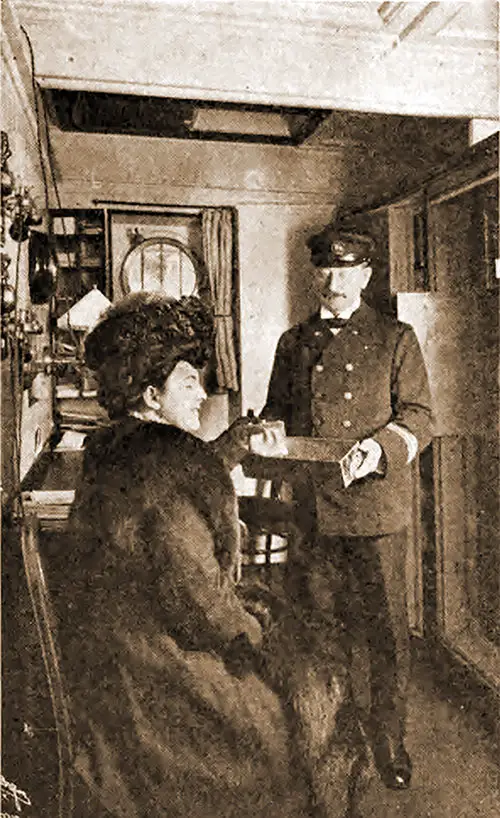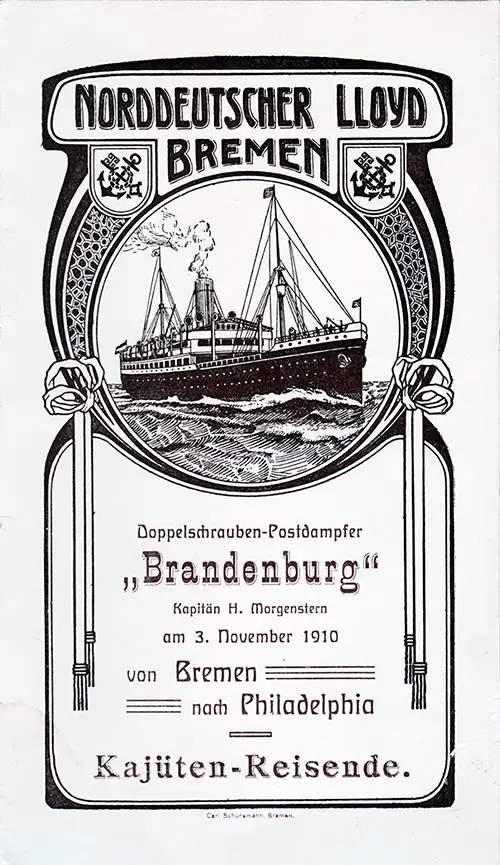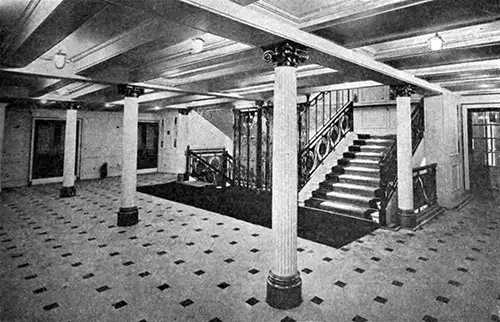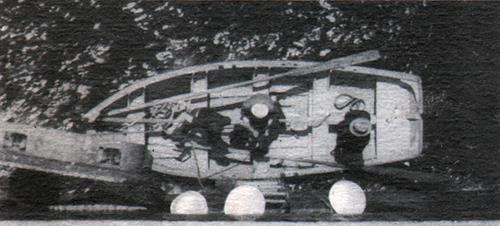What to Expect on Your Transatlantic Voyage - 1910
This section covers the day before sailing, time of sailing, the role of stewards, passenger lists, getting underway, and what you're likely to see during your transatlantic voyage.
The Day Before Sailing
It is always wise to visit the steamer the day before sailing when this is possible. This enables the necessary inquiries, such as the location of seats at the table, and steamer chairs, etc., to be settled decidedly. If the seats cannot be assigned at that time, one can make at least a reservation.
The Voyage - What to Expect
It is a good rule to always be at the dock a full hour before the advertised time of sailing. This will enable you to look after your baggage and see that the smaller baggage articles are placed in the stateroom.
The stewards will usually, on request, lock the stateroom to prevent the possible theft of hand-baggage, rugs, umbrellas, etc.
The company assumes no responsibility for loose baggage unless placed in the hands of the baggage-master. Visitors from other cities should aim to reach New York the day before sailing. The same remarks apply to those who sail from Philadelphia, Boston, etc.
Ample time must be allowed to transfer baggage from railroad stations to the pier. After a reasonable time has been allowed for the express company to make the transfer, the pier should be called up.
The baggage-master should be inquired for, then make your inquiries about whether the baggage has been received, specify the number of pieces, and the style, as "steamer trunk," "Saratoga, trunk," etc. In case of non-receipt,' call up the express company and have the matter traced at once.
If visitors stop at a hotel or private house where all the baggage is collected, one should take a cab to the pier. Allow ample time not only for the run but for waiting at the pier, as there will be many carriages on the day of sailing.
When the vehicle comes near the gangplank, the passengers should alight, and the baggage master should be asked to put the steamer trunk and hand-baggage in the stateroom.
Stewards

Purser Assists a Passenger in Storing Her Valuables in the Purser's Safe Deposit Vault. GGA Image ID # 17bcfab3c9
Stewards are on hand to make the transfer. Trunks that are not wanted during the voyage should have a "hold" label or label that says, "not wanted."
Steamer trunks that may be needed during the journey should have a "wanted" label attached; the steamer trunks will then put them in a place where access can be had during the voyage upon proper notice the purser or other official in charge.
After the baggage has been disposed of, the visitor should buy such reading matter as needed from the newsstand. The stateroom should be sought out.
If the stewards lock up the baggage, there will be less anxiety than if the stateroom is left open. The passenger should then repair to the deck to meet his friends.
In the height of the season and on a large steamer, it is sometimes wise to ask your friends to meet you in some foreordained place, such as the music-room, the lounge, the main saloon, the main deck, or near the purser's office.
Passenger Lists

Front Cover of a Cabin Passenger List from the SS Brandenburg of the Norddeutscher Lloyd, Sailing from Bremen to Philadelphia on 3 November 1910. GGA Image ID # 17bce2dbe2
One can obtain lists of passengers in printed form at the purser's office, chief steward's office, or in the saloon before leaving. One should remember that many persons engage passage a few hours before sailing. The steamer lists are only accurate in a general way.
There are usually enough steamer lists so that visitors can take one away with them. The seating at the table is referred to elsewhere, also steamer chairs.
Getting Underway
Ocean steamers promptly sail at the scheduled time unless they are held back by some unforeseen circumstance, such as fog. After bidding good-bye to friends, it is interesting to stay on deck until the vessel warps out and she turns her how seaward in midstream. The trio down the bay is, of course, always interesting even to New Yorkers.
Ellis Island, the Statue of Liberty, Staten Island, and Coney Island are soon left behind. In the meantime, the sailors have been getting out the sea ladder for the pilot's descent; at last, the steamer is abaft the pilot boat with its yellow funnel looking not unlike a private yacht.

Spacious Companionway of the RMS Lusitania Showing Elevators. GGA Image ID # 17bd109bb4
A rowboat is put off from the steam pilot boat, and the sailors throw the rowers the rope, and the ship is trailed alongside and brought underneath the sea ladder.
There is a sharp clank-clank in the engine-room of the signals, and the machinery stops while the pilot with his little bag of mail shakes hands with the captain and disappears over the rail.
He reaches the rowboat, and the rope is cast off. As soon as it is a safe distance from the ship, clank-clank goes the engine signal from the bridge. Normally, the machinery never stops again until a foreign port is reached.

Pilot's Departure From the Ship in Rowboat To Be Taken Back To Station at Sandy Hook. GGA Image ID # 17bd3f68a0
The pilot's departure is the last bit of excitement which the passenger is apt to have unless another vessel is sighted during the trip, a whale, or in extreme cases, an iceberg; one can see gulls and porpoises almost daily during the trip.
A whale's sighting is not so unusual at sea as a passenger may think; he may see two for every five voyages. This is based on the experience of the writer.
The next point of land that will be seen will usually be the coast of Ireland or the Scilly Islands. The passenger is now free to enjoy the good cheer and the amusements that the ship affords.
The traveler does not feel so entirely cut off from the world with the invention of the wireless as in former years when the only pews of any description which could be received came from another vessel was met somewhere in the great ocean lane.
